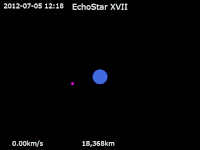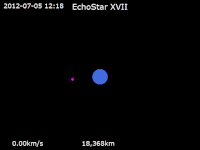
Back Геапераходная арбіта Byelorussian Геостационарна трансферна орбита Bulgarian Přechodová dráha ke geostacionární dráze Czech Geostationäre Transferbahn German Orbito de geosinkrona transiro Esperanto Órbita de transferencia geoestacionaria Spanish مدار انتقالی زمینایستا Persian Geostationaarinen siirtorata Finnish Orbite de transfert géostationnaire French מסלול מעבר למסלול גאוסטציונרי HE
This article has multiple issues. Please help improve it or discuss these issues on the talk page. (Learn how and when to remove these template messages)
|
A geostationary transfer orbit (GTO) or geosynchronous transfer orbit is a type of geocentric orbit. Satellites that are destined for geosynchronous (GSO) or geostationary orbit (GEO) are (almost) always put into a GTO as an intermediate step for reaching their final orbit.
A GTO is highly elliptic. Its perigee (closest point to Earth) is typically as high as low Earth orbit (LEO), while its apogee (furthest point from Earth) is as high as geostationary (or equally, a geosynchronous) orbit. That makes it a Hohmann transfer orbit between LEO and GSO.[1]
While some GEO satellites are launched directly to that orbit, often times the launch vehicle lacks the power to put both the rocket and the satellite into the particular orbit. So, extra fuel is added to the satellite, the launch vehicle launches to a geostationary transfer orbit; then the satellite circularises its orbit at geostationary altitude. This benefits from staging: the launch vehicles and the mass of its structure and engines do not need to be lifted up to a circular geostationary altitude.
Manufacturers of launch vehicles often advertise the amount of payload the vehicle can put into GTO.[2]
© MMXXIII Rich X Search. We shall prevail. All rights reserved. Rich X Search

